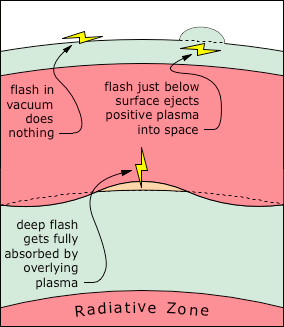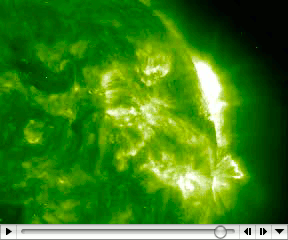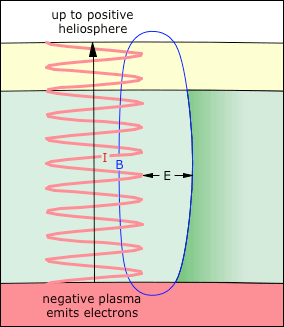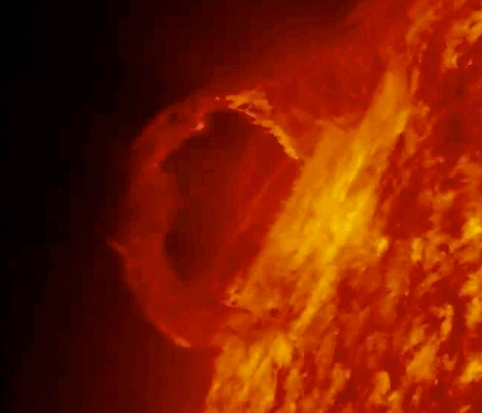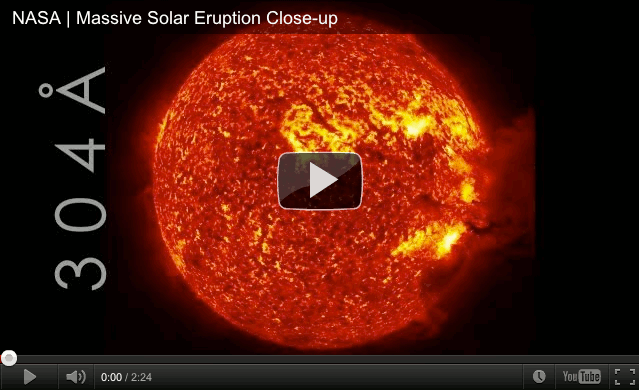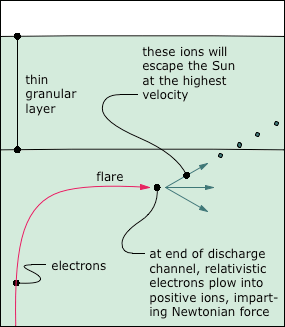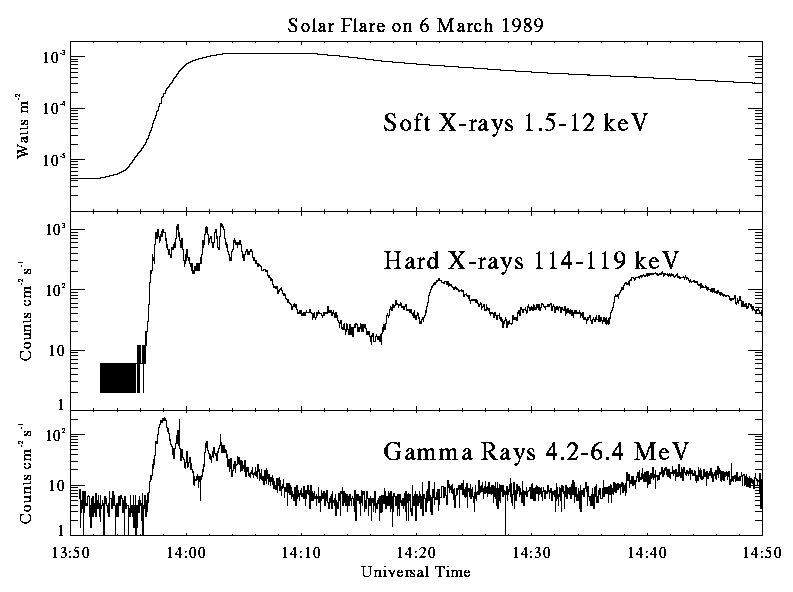© Charles ChandlerThe Conversions section identified CMEs as the critical enabler in the sustained electric current between the Sun and the heliosphere, because they deplete the supply of positive ions on top of the negative layer, so CMEs deserve a more detailed analysis. CMEs are the consequence of flashes below yet near the surface. (See Figure 1.) So we should like to know what causes the flashes. Then we can study the dynamics of the ejections themselves.Sub-surface flashes are frequently preceded by a sudden disappearance of coronal loops.1,2,3 Since coronal loops are manifestations of magnetic fields, the standard model explains that the magnetic lines of force "reconnected" below the surface, leading to a huge release of energy. In the words of Wikipedians:Scientific research has shown that the phenomenon of magnetic reconnection is responsible for solar flares. Magnetic reconnection is the name given to the rearrangement of magnetic lines of force when two oppositely directed magnetic fields are brought together. This rearrangement is accompanied with a sudden release of energy stored in the original oppositely directed fields.While that may be the standard answer, here's what the Australian Space Weather Agency said on the topic:The bottom line is that at this stage in solar physics we do not really know what produces a flare nor what produces a coronal mass ejection. There are competing theories, but all tend to have deficiencies with respect to matching the observational evidence. We certainly believe that they all depend on the reconfiguration of magnetic fields as their primary energy source, but in the final analysis, we really only believe this because we can conceive of no other solar energy source of sufficient magnitude.If they can conceive of the magnetic force, why can't they conceive of the electric force? After all, in the absence of magnetized particles, the only thing that can generate magnetic fields is the movement of charged particles (i.e., an electric current), which means that the prime mover is the electric field. Not starting there can only lead to mistakes. Four of these are described below.First, in the most general sense, the reconnection literature does not identify the magnetomotive force responsible for coronal loops, nor the nature of the explosive release of the energy "stored" in them. The term "reconnection" doesn't even appear in electrical engineering textbooks, and hasn't been demonstrated in any laboratory. In short, the model doesn't have a physical foundation.Second, it's quite obvious that a flare in the extremely thin corona is not going to produce a CME — a flash in a vacuum is just a flash, but a flash in a dense medium is an explosion. (See Figure 1.) So some of the literature specifies that a CME is the result of reconnection below the surface. But there, the magnetic permeability is much lower. How does energy incapable of flashing in the high-permeability corona become explosive in the lower-permeability plasma below the surface?Figure 2. This sequence of flares, from 2003-10-17 to 2003-11-05, included the largest ever recorded, courtesy SOHO. (Click this to play the movie.)Third, coronal loops are the most powerful after the flare. If the flare is the release of magnetic potential, the post-flare loops should be weaker. (See Figure 2.)Fourth, by latching onto coronal loops as the central piece, the reconnection model gets everybody thinking of flares and CMEs as the release of potential between two coupled active regions. Even models that neglect magnetic fields incorporate this preconception. For example, one theory is that flares are arc discharges that release electrostatic potentials between oppositely charged sunspots (begging the question of what separated the charges in the excellent conductivity of 6000 K plasma). The mistake is in the premise, as there is no evidence of flares connecting two sunspots. Rather, a flare is between an active region and the surrounding positive double-layer. One flare might trigger another, and before the entire event is over, a pair of coupled sunspots might both have discharged into the granules, but never at the same time, never directly from one sunspot to another, and never following the magnetic field lines.Clearly, the relationships among sunspots, flares, CMEs, and post-flare loops are more complex than they're given credit, and we'll have to pay close attention to the details to work it out.To start, there is direct evidence that solar flares are arc discharges.4,5,6 This asks many questions.
- What sort of charge separation mechanism could sustain the potentials for such huge flashes, in the excellent conductivity of 6000 K plasma (as asked just above)?
- Why, specifically, would the discharge be between the active region and the surrounding quiet areas?
- And why not toward another active region?
Figure 3. The magnetic field (B) of the sunspot maintains a charge separation, by braking the flow of +ions toward the negative charge inside the sunspot.The thing that keeps opposite charges from recombining, until extreme potentials have developed, is certainly not any sort of insulator. And the horizontal charge separation mechanism across the surface is not electron degeneracy pressure, which can only be vertical. There is only one other possibility: magnetic pressure. The electrons spiraling toward the heliosphere are generating powerful B-fields. Once the fields superpose into an organized form, any electron attracted to the positive double-layer would have to fight the combined magnetic field to get there. (See Figure 3.) As the current density increases, the plasma in the sunspot shaft thins out, due to ohmic heating. Thus there are fewer positive ions, and more electrons, in the spiraling current. The increased charge density inside the current attracts a stronger positive double-layer (shown as darker green in Figure 3). But it also generates more powerful magnetic fields that keep the charges from recombining. So if the current density is steady, or increasing, the horizontal E-field between negative charges inside the sunspot shaft and positive charges outside of it can continue to build.But what if the current relaxes? Then the magnetic pressure goes away, and the opposite charges are free to recombine. Having built up to extreme charge densities, the recombination might be catastrophic.In this context, it makes sense that flares are preceded by sudden disappearances of coronal loops. If the current relaxes, the solenoidal B-field that it was generating relaxes as well. So the coronal loops go away, and then there is a flare, and not because of "magnetic reconnection" below the surface, but because of the expiration of the magnetic pressure, enabling "electric reconnection" (if you will).It also makes sense that after the flare, the coronal loops come back, and far more vigorously. The loops are manifestations of a solenoidal magnetic field, and the magnetomotive force is a vertically oriented electric current responding to the solar~heliospheric E-field. If the B-field is more dense, the electric current must be more robust. This is expected if the flare ejected a large volume of positive plasma, leaving the Sun with even more of a net negative charge, and creating an even higher potential between the Sun and the heliosphere.In cases where two proximal sunspots are generating opposite-polarity solenoids, the axial lines of force will be coupled. If one of the consequences of the flare is that there is a disparity in charge density between the sunspots, an electric current will flow between them, and it will follow the magnetic field lines.7,8:9 The density of such currents has been estimated (perhaps conservatively) at 1~3 A/m2.8:11 Whatever it is, that's a lot compared to the solar~heliospheric current, which is 5.40 × 10−4 A/m2. So flares leave major charge disparities between sunspots, and with the magnetic lines of force already there, healthy currents flow from one sunspot to the other.Now we can consider the properties of the CMEs themselves. The Wikipedia article lays out the basics.A typical coronal mass ejection may have any or all of three distinctive features: a cavity of low electron density, a dense core (the prominence, which appears as a bright region on coronagraph images embedded in this cavity), and a bright leading edge.Coronal mass ejections reach velocities between 20 km/s to 3200 km/s with an average speed of 489 km/s, based on SOHO/LASCO measurements between 1996 and 2003. The average mass is 1.60 × 1012 kg. The values are only lower limits, because coronagraph measurements provide only two-dimensional data analysis. The frequency of ejections depends on the phase of the solar cycle: from about one every fifth day near the solar minimum to 3.5 per day near the solar maximum. These values are also lower limits because ejections propagating away from Earth (backside CMEs) can usually not be detected by coronagraphs.Current knowledge of coronal mass ejection kinematics indicates that the ejection starts with an initial pre-acceleration phase characterized by a slow rising motion, followed by a period of rapid acceleration away from the Sun until a near-constant velocity is reached. Some balloon CMEs, usually the slowest ones, lack this three-stage evolution, instead accelerating slowly and continuously throughout their flight. Even for CMEs with a well-defined acceleration stage, the pre-acceleration stage is often absent, or perhaps unobservable.The "cavity of low electron density" makes sense if the granular layer is positively charged. But if we think of a CME as an explosive event, the kinematics do not make sense, especially for a "balloon" CME. (See Figure 4. Click the SDO link to watch the movie.) Its physical dimensions are larger than all other types, suggesting that the "explosion" was a lot larger. But instead of instantaneously achieving peak velocity, the plasma starts slowly and constantly accelerates. More interestingly, the interior is clear, while the boundary is opaque, and the plasma around the outside sheds off the bubble and falls back into the Sun, frequently moving at relativistic speeds. All in all, it looks like a balloon bursting (hence the name), but that's a descriptive metaphor, not an explanation.The movie associated with Figure 5 shows a CME that was well below the surface, as we see expansion before there is evidence of a flare, and a huge volume of plasma is ejected. Yet the "balloon" quickly breaks. Some material continues on out into space, but the majority is pulled back into the Sun. Notice the non-ballistic trajectories of the parcels, and their relativistic velocities. Clearly, a force far more powerful than gravity is pulling the plasma back, and directing it toward specific points of entry back into the Sun. This can only be evidence of EM forces.Sorting this out requires returning to the electrostatic model, which has electrons being accelerated away from the Sun, and positive ions being pulled inward. In this context, we can think of the clear interior as free electrons, and the dark boundary as positive ions. An explosive event below the surface accelerates positive ions outward, initiating the bubble. This draws free electrons out of the underlying negative layer, which fill up the interior of the "balloon." We can expect flashes in the corona due to charge recombination (hence the "bright leading edge"), but opposite charges that do not recombine will be accelerated in opposite directions in the 1.7 GV electric field. Electrons moving away from the current divider will pick up speed in the direction of the heliosphere, while positive ions will be pulled forcefully back into the Sun.Note that these rare balloon CMEs are not depleting the store of positive ions, and thereby driving the solar~heliospheric current. Rather, they would seem to expel more electrons than ions. (At least that's the interpretation within the present model, and which seems to be necessary to explain the bidirectional acceleration.) So in the present model, balloon CMEs are the rare exceptions, where the rule is that CMEs deplete the positive charge in the topmost 20 Mm. The estimate of the solar mass loss due to CMEs (i.e., 3.43 × 107 kg/s) that was used in the Conversions section to calculate the solar~heliospheric current density is of course based on the mass of the nucleons, not the electrons.One other aspect of the event in Figure 5 is worth mentioning. We can clearly see that the plasma getting pulled back down is opaque at 304 Å. Interestingly, this is a wavelength that hydrogen and helium cannot absorb, so this is primarily iron plasma. Yet solar spectroscopy estimates the surface of the Sun to be 75% hydrogen, 25% helium, and only 1 part in 30,000 of iron.9 Some researchers believe that this is evidence of much greater quantities of iron in the convective zone, while the present model offers another suggestion. It was noted earlier that the pre-flare solar~heliospheric current in the sunspot shaft attracts a positive double-layer, though the magnetic field prevents charge recombination. And what species of +ions would make up this positive double-layer? Hydrogen has an extremely high ionization potential, while heavier elements can lose electrons more easily. Thereafter, the +ions can get accelerated by the electric force. So we can expect the atoms in the positive double-layer around the sunspot shaft to have a concentration of heavy elements (such as iron) way out of proportion to their average abundances in the convective zone. If a flare occurs and there is a CME, the constitution of the ejected plasma will be misrepresentative of the average abundances in the convective zone.We should also wonder how arc discharges cause such explosive events. Some think that it's just the rapid expansion of the discharge channel, because of ohmic heating. While the temperature is well into the MK range, the slowest CME speeds (i.e., 20 km/s) are still supersonic for that temperature, ruling out simple thermal expansion.The first realistic candidate for such an accelerator is relativistic electrons colliding with positive ions. On Earth, the electrons in lightning traveling ~5 km achieve approximately 1/10 the speed of light. Discharges in the Sun can extend more than 100 Mm, and it's possible that the electrons achieve speeds over 9/10 the speed of light. As these electrons evacuate the discharge channel, the collisions will be extremely high-energy events, creating a supersonic shock wave propagating outward.Evidence of this relativistic electron drag might be the so-called "proton storms" that sometimes hit the Earth at extreme velocities. One of the most vigorous of these on record occurred 2005-01-20, and the protons travelled at 1/3 the speed of light on their way to the Earth.10 Such proton storms tend to occur when the solar flare is at 60° west longitude.11 Assuming that the discharge was parallel to the surface of the Sun, and the azimuth of the discharge was pointing in our direction, the highest-velocity particles would be those scattered slightly upward (such as at a 30° angle). (See Figure 6.)Somewhat more significantly, when the electrons plow into stationary plasma at the end of the channel (perhaps analogous to the "beads" at the ends of stepped leaders in terrestrial lightning), the instantaneous increase in temperature and pressure might create the conditions necessary for nuclear fusion.4,12,13 If this is the case, CMEs are at least partially thermonuclear explosions, and relativistic ejecta are easy to understand.The direct data from the explosions themselves also seem to fit nicely into the arc discharge model. (See Figure 7.) The rise in soft X-rays preceding the flare is consistent with an electric arc. The hard X-rays and gamma-rays are indicative of nuclear fusion, and the "impulsive" increases are analogous to stepped leaders in terrestrial lightning.Figure 7. In the preflare stage (13:50 to 13:56 UT), the soft X-ray emission gradually increased, but little if any hard X-rays or gamma rays were detected above the instrumental background level. This was followed by the so-called impulsive phase, in which the hard X-ray and gamma-ray emission rose impulsively, often with many short but intense spikes of emission, each lasting a few seconds to tens of seconds. (Data and description courtesy NASA.)
1. Pojoga, S.; Huang, T. S. (2003): On the sudden disappearances of solar filaments and their relationship with coronal mass ejections. Advances in Space Research, 32 (12): 2641-2646 ⇧
2. Soru-Escaut, I.; Mouradian, Z. (1990): Sudden disappearance and reappearance of solar filaments by heating and cooling. Astronomy and Astrophysics, 230: 474-478 ⇧
3. Taliashvili, L.; Mouradian, Z.; Páez, J. (2008): Dynamic disappearance of prominences and their geoeffectiveness. Geofísica internacional, 47 (3) ⇧
4. Mozina, M.; Ratcliffe, H.; Manuel, O. (2006): Observational confirmation of the Sun's CNO cycle. Journal of Fusion Energy, 25: 107-114 ⇧ ⇧
5. Veselovsky, I. (2008): Universal and important physical process in space plasmas: electric charge separation. 37th COSPAR Scientific Assembly, 37: 3332 ⇧
6. Lee, T. N. (1974): Solar-flare and laboratory plasma phenomena. Astrophysical Journal, 190: 467-479 ⇧
7. Ryutova, M. (2006): Coupling effects throughout the solar atmosphere: 2. Model of energetically open circuit. Journal of Geophysical Research, 111 (A9): A09102 ⇧
8. Ryutova, M. P.; Frank, Z.; Hagenaar, H.; Berger, T. (2011): Flares Producing Well-organized Post-flare Arcades (Slinkies) Have Early Precursors. The Astrophysical Journal, 733 (2): 125 ⇧ ⇧
9. Anders, E.; Grevesse, N. (1989): Abundances of the elements: Meteoritic and solar. Geochimica et Cosmochimica Acta, 53 (1): 197-214 ⇧
10. Wikipedia (2011): Solar Flare. ⇧
11. Lin, R. (2005): A New Kind of Solar Storm. NASA ⇧
12. Gurevich, A. V. et al. (2012): Strong Flux of Low-Energy Neutrons Produced by Thunderstorms. Physical Review Letters, 108 (12): 125001 ⇧
13. Watanabe, K. et al. (2010): G-band and Hard X-ray Emissions of the 2006 December 14 flare observed by Hinode/SOT and RHESSI. arXiv.org, 1004.4259 ⇧











